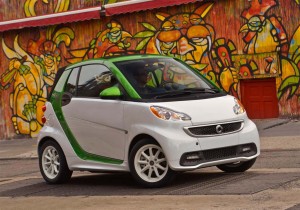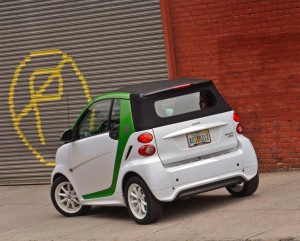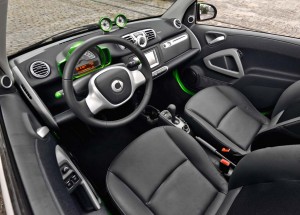Why aren’t consumers getting charged up about battery cars? That’s the question a lot of folks have been asking as sales lag well behind earlier expectations.
Range is clearly a concern, motorists worrying about being able to go – with most models – less than 100 miles per charge. But the big issue appears to be price. Electric vehicles simply carry too steep a premium for many potential buyers.
That’s something little Smart hopes to address when it introduces what it is billing as the lowest-priced battery vehicle coming to the U.S. market from a major manufacturer. The 2013 Smart fortwo ED – short for Electric Drive – will carry a base price of just $25,780. (Not including a $750 delivery charge.)
That’s a substantial discount from other plug-ins and pure battery-electric vehicles, or BEVs, such as the Chevrolet Volt and Nissan Leaf, and nearly $4,200 below the current price champ, the $29,975 Mitsubishi i-MiEV.
The Smart fortwo ED Cabriolet edition, meanwhile, will bump the price tag to $28,000. But both the coupe and convertible qualify for the federal government’s $7,500 tax credit – which would get a buyer into one of the new battery cars for as little as $18,280. And some customers could qualify for state and local incentives, as well.
The Smart ED is actually the second version of the battery car which is produced by the down-market sibling of Daimler AG’s Mercedes-Benz brand. The new version gets an updated 17.6 kilowatt-hour lithium-ion battery designed to improve the earlier model’s less than stellar range and performance.
That said, the low price tag is a tip-off that neither will be world-beaters.
The 2013 Smart fortwo ED gets an upgraded 55 kilowatt motor making 47 horsepower. That’s up from just 30 hp previously. Meanwhile, the 2-seater also adds an electric turbocharging mode capable of producing 74 hp for a 2-minute burst – though that will rapidly eat into battery range. But it will help you launch from 0 to 60 in 11.5 seconds. As noted, no rocket ship, but that’s actually a wee bit faster than the conventional, gas-powered version of the Smart fortwo.
Range hasn’t yet been revealed but something on the order of 90 miles is being hinted at, better than the i-MiEV and about on par with other, more expensive battery models, at least if the EPA ultimately confirms that figure.
Potential customers should consider that it makes a lot of sense to add a 220-volt Level II charger, which could cost $1,000 or more to install. But it allows for much quicker charging time – and in many markets, customers could then qualify for reduced electric rates. With a 220V system it takes six hours to recharge, Smart says, though going from 20% to 80% of capacity can be achieved in about 3.5 hours.



